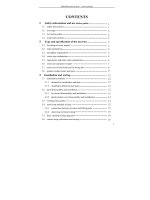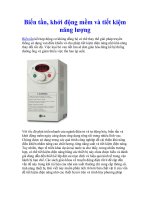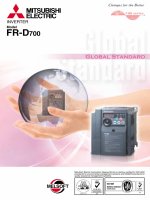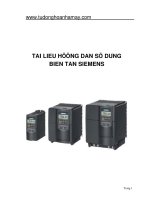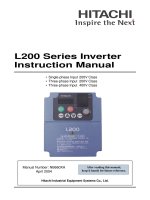Tài Liệu Biến Tần INVT CHE160A
Bạn đang xem bản rút gọn của tài liệu. Xem và tải ngay bản đầy đủ của tài liệu tại đây (2.97 MB, 147 trang )
CHV160A series special inverter for water supply
1
Contents
Contents.................................................................................................................................1
SAFETY PRECAUTIONS........................................................................................................3
1. INTRODUCTION.................................................................................................................4
1.1 Technology Features...............................................................................................4
1.2 Features of Water Supply System............................................................................5
1.3 Description of Nameplate........................................................................................6
1.4 Working Diagram of CHV160A Water Supply Special Inverter..................................7
1.5 Selection Guide.......................................................................................................7
1.6 Parts Description.....................................................................................................8
2. UNPACKING INSPECTION...............................................................................................10
3. DISASSEMBLE AND INSTALLATION...............................................................................11
3.1 Environmental Requirement..................................................................................11
4. WIRING............................................................................................................................13
4.1 Connections of Peripheral Devices........................................................................14
4.2 Terminal Configuration...........................................................................................14
4.3 Typical Wiring Diagram..........................................................................................16
4.4 Wiring the Main Circuits.........................................................................................17
4.5 Wiring Control Circuit Terminals.............................................................................20
4.6 Installation Guidline to EMC Compliance...............................................................22
5. OPERATION.....................................................................................................................26
5.1 Operating Keypad Description...............................................................................26
5.2 Operation Process.................................................................................................28
5.3 Running State........................................................................................................30
6. DETAILED FUNCTION DESCRIPTION.............................................................................31
P0 Group--Basic Function...........................................................................................31
P1 Group--Start and Stop Control................................................................................37
P2 Group--Motor Parameters......................................................................................41
P3 Group --PID Control...............................................................................................42
P4 Group--V/F Control................................................................................................48
P5 Group--Input Terminals...........................................................................................51
P6 Group -- Output Terminals......................................................................................56
P7 Group--Display Interface........................................................................................60
P8 Group--Water-supply Function...............................................................................66
CHV160A series special inverter for water supply
2
P9 Group--Timing Watering and Multi-given Function Group........................................73
PA Group--Protection Parameters................................................................................75
Pb Group --Serial Communication...............................................................................81
PC Group --Enhanced Function...................................................................................83
Pd Group--PID Enhanced Function.............................................................................87
PE Group—Factory Setting.........................................................................................88
7. TROUBLE SHOOTINGT.................................................................................................89
7.1 Fault and trouble shooting.....................................................................................89
7.2 Common Faults and Solutions...............................................................................93
8. MAINTENANCE................................................................................................................94
8.1 Daily Maintenance.................................................................................................94
8.2 Periodic Maintenance............................................................................................95
8.3 Replacement of wearing parts...............................................................................96
9. COMMUNICATION PROTOCOL.......................................................................................97
9.1 Interfaces..............................................................................................................97
9.2 Communication Modes..........................................................................................97
9.3 Protocol Format.....................................................................................................97
9.4 Protocol function....................................................................................................98
9.5 Note....................................................................................................................103
9.6 CRC Check.........................................................................................................103
9.7 Example..............................................................................................................103
10. DESCRIPTION OF WATERING EXTENSION CARD......................................................110
10.1 Description of Model..........................................................................................110
10.2 External Dimension...........................................................................................110
10.3 Installation.........................................................................................................110
APPENDIX A RELATIVE DIMENSION OF INVERTER.........................................................111
A.1 External Dimension.............................................................................................111
A.2 Installation Space................................................................................................112
A.3 Dimensions of External Keypad...........................................................................113
A.4 Disassembly.......................................................................................................114
APPENDIX B SPECIFICATIONS OF ACCESSORIES..........................................................115
B.1 Specifications of Breaker, Cable, Contactor and Reactor.....................................115
APPENDIX C FUNCTION PARAMETERS...........................................................................117
APPENDIX D WATERING STANDARD WIRING DIAGRAM................................................142
CHV160A series special inverter for water supply
4
1. INTRODUCTION
1.1 Technology Features
● Input & output
u Input voltage range: 380±15%
u Input frequency range: 47~63Hz
u Output voltage range: 0~rated input voltage
u Output frequency range: 0~400Hz
● I/O features
u Programmable digital input: Provide 8 inputs
u Programmable analog input: AI1 and AI2, which can accept 0~10V or 0~20mA.
u Relay output: Provide 3 output terminals. 8 outputs can be extended by
Water-supply extension card.
u Analog output: Provide 2 output terminal(0/4-20mA or 0/2-10V).
u Communication interface: standard RS485 serial port
● Main control function
u Control mode: V/F control.
u Overload capacity: 60s with 120% of rated current, 10s with 150% of rated current,
u Speed adjusting range: 1:100
u Carrier frequency: 1.0 kHz~16.0 kHz.
● Functions
u Frequency reference source: Digital input, analog input, PID Input,etc.
u DC braking at starting and stopping
u Sleep wake function.
u PID Control Function for water supply or other occasions
u Programmable digital input and output
u Skip frequency control function
u None-Stop when instantaneous power off.
u Speed Trace Function: Smoothly start the running motor.
u QUICK/JOG: User defined shortcut key can be realized.
u Automatic Voltage Regulation Function (AVR):
u Up to 26 fault protections: Protect from over current, over voltage, under voltage,
over temperature, phase failure, over load etc.
CHV160A series special inverter for water supply
5
1.2 Features of Water Supply System
u Support two kinds of water supply mode: fixed frequency pump mode and
circulating pump mode.
u Flexibility control logic to add, subtract pump.
u Up to eight segment pressure settings which change pressure given in different
time.
u 16 segment of the pressure given by different combination of input terminals.
u Sleep pump control functions: Support flexible sleep mode, the small sleep pump
will start automatically at sleep state in order to maintain sleep pressure effectively.
Once meeting the wake-up conditions, the system will come out of hibernation
automatically, and stop the small sleep pump.
u Regular rotation control, which can prevent the pump seizing by corrosion
effectively, and prevent one pump running all the time. It is suggested that the
power of rotation pumps should be fairish, otherwise it will cause the system
pressure fluctuating.
u Sewage pump control functions, which is used to detect water level of cesspool
and control water level of cesspool.
u Inlet basin water-level detection and control functions, which can detect liquid level
of inlet basin, and adjust pressure-given automaticly.
u Ultra- voltage, under-voltage alarm function of pipe network, inverter supports
ultra- voltage, under-voltage alarm output functions, which can outputs through
programmable relay.
u Set up to motor rated current parameters of no less than seven pumps, and
achieve over-current, overload and other protection for the current pump-run.
u Record failure pump: Record failure pump automatically, and if cleared this record,
please use function of fault clearance.
u Provides standard RS485 Physics communication mode, using master-slave
communication though international standard Modbus communication protocol,
electrical parameters in full compliance with international standards, which can be
achieved barrier-free communication between CHV160A inverter special for water
supply system and the host computer.
CHV160A series special inverter for water supply
6
1.3 Description of Nameplate
SHENZHEN INVT ELECTRIC CO.,LTD.
MODEL: CHV160A-045G-4 SPEC:V2
POWER:45kW
OUTPUT: 90A AC 0~380V 0~400Hz
INPUT: AC 3PH 380V±15% 50/60Hz
Bar code
MADE IN CHINA
Bar code
Output specification
Input specification
Power
Model number
Company name
CHV160A-045G-4
Close loop vector
control inverter
The first generation
Input voltage
4: 3AC 380V
G: Constant
torque
Power rating
045: 45kW
0: Universal type
6: Only for water supply
A: Enhanced
Figure 1.1 Nameplate of inverter
CHV160A series special inverter for water supply
7
1.4 Working Diagram of CHV160A Water Supply Special Inverter
Intake sump
Sewage
pump
CHV160 Inverter
Pressure
display
Pressure
feedback
Pressure
given
Sewage
pump
Fixed frequency
pump or circulating
pump
drained
water
Ring shaped
network
Networ
1 for life
Networ 2
for life
Networ
for
industry
Water
level
control
Figure 1.2 Working diagram of the CHV160A water supply special inverter
1.5 Selection Guide
3AC 380V±15%
Model No. Rated power (kW)
Rated input
current (A)
Rated output
current (A)
CHV160A-5R5-4 5.5 15.0 13.0
CHV160A-7R5-4 7.5 20.0 17.0
CHV160A-011-4 11.0 26.0 25.0
CHV160A-015-4 15.0 35.0 32.0
CHV160A-018-4 18.5 38.0 37.0
CHV160A-022-4 22.0 46.0 45.0
CHV160A-030-4 30.0 62.0 60.0
CHV160A-037-4 37.0 76.0 75.0
CHV160A series special inverter for water supply
8
Model No. Rated power (kW)
Rated input
current (A)
Rated output
current (A)
CHV160A-045-4 45.0 90.0 90.0
CHV160A-055-4 55.0 105.0 110.0
CHV160A-075-4 75.0 140.0 150.0
CHV160A-090-4 90.0 160.0 176.0
CHV160A-110-4 110.0 210.0 210.0
CHV160A-132-4 132.0 240.0 250.0
1.6 Parts Description
Figure 1.3 Part name of inverter (Less than 18.5kW)
CHV160A series special inverter for water supply
9
Cover the fixed hook mouth
Operating keypad
Control board
Control terminal
PG card expansion
Keypad bracket
Shield plate
Functional card
Main circuit terminal
Control cable inlet
Installation hole
Figure 1.4 Part name of inverter (22kW ~132kW)
CHV160A series special inverter for water supply
12
will be derated when the altitude is higher than 1000m. For details, please refer to the
following figure:
Iout
100%
80%
60%
40%
20%
1000 2000 3000 4000
(m)
Figure 3.1 Relationship between output current and altitude
3.1.4 Impact and oscillation
It is not allowed that the inverter falls down or suffers from fierce impact or the inverter
installed at the place that oscillation frequently. The maximum swing should less than
5.8m/s
2
(0.6g).
3.1.5 Electromagnetic radiation
Keep away from the electromagnetic radiation source.
3.1.6 Water
Do not install the inverter at the wringing or dewfall place.
3.1.7 Air pollution
Keep away from air pollution such as dusty, corrosive gas.
3.1.8 Storage
Do not store the inverter in the environment with direct sunlight, vapor, oil fog and
vibration.
CHV160A series special inverter for water supply
15
Figure 4.4 Main circuit terminals (22~132kW)
Main circuit terminal functions are summarized according to the terminal symbols in the
following table. Wire the terminal correctly for the desired purposes.
Control Circuit Terminals
+10V
GND
AI1
AI2
COM
S1
S2
S3
S4
S5
S6
PE
GND AO1
AO2 24V
PW COM
S7 S8
485+ 485-
RO1A RO1BRO1C
RO2A RO2BRO2C
RO3A RO3B
RO3C
Figure 4.5 Control circuit terminals.
RT1ART1B
RT2ART2B
RT3ART3B
RT4ART4B
RT5ART5B RT7ART7B
RT8ART8BRT6ART6B
Figure 4.6 terminals on the water supply control card
Terminal Description
R、S、T
Terminals of 3 phase AC input
(+)、(-)
Spare terminals of external braking unit
(+)、PB
Spare terminals of external braking resistor
P1、(+)
Terminal of ground
(-)
Terminal of negative DC bus
U、V、W
Terminals of 3 phase AC output
Terminal of ground
CHV160A series special inverter for water supply
16
4.3 Typical Wiring Diagram
+
Main circuit
Braking
Resister
BR2
(+)
(-)
(+)
P1
M
PE
U
V
W
T
S
R
Protect circuit
(-)
BR1
{
{
+24V connect to PW
+24V
PW
PE
V
I
J5
Interface For
Water-supply Card
Interface For
EXternal Keypad
CN8
S6
S5
CHV160A
control board
S1
S2
S3
S4
COM
+10V
AI1
AI2
GND
PE
RO2A
RO2B
RO2C
GND
AO2
Frequency/PID
setting
IV
J12
Analog Output
0-10V/0-20mA
GND
AO1
IV
J10
Anolog Output
0-10V/0-20mA
S8
S7
{
RO1B
RO1C
RO1A
RO3C
RO3B
RO3A
RS485+
RS485-
GND
External Braking Unit
3 phase
380V±15%
50/60Hz
Multifunctional on-off
input 1
Multifunctional on-off
input 2
Multifunctional on-off
input 3
Multifunctional on-off
input 4
Multifunctional on-off
input 5
Multifunctional on-off
input 6
Multifunctional on-off
input 7
Multifunctional on-off
input 8
Relay output 1
V I
J9
J11
0-10V input
0/4-20mA input
Relay output 1
Relay output 2
Jumper select I or V
DCL DC
Reactor
Figure 4.7 Wiring diagram.
CHV160A series special inverter for water supply
17
4.4 Wiring the Main Circuits
4.4.1 Wiring at the side of power supply
●Circuit breaker
It is necessary to connect a circuit breaker which is compatible with the capacity of
inverter between 3ph AC power supply and power input terminals (R, S, T). The
capacity of breaker is 1.5~2 times to the rated current of inverter. For details, see
<Specifications of Breaker, Cable, and Contactor.
●Contactor
In order to cut off the input power effectively when something is wrong in the system,
contactor should be installed at the input side to control the ON-OFF of the main circuit
power supply.
●AC reactor
In order to prevent the rectifier damage result from the large current, AC reactor should
be installed at the input side. It can also prevent rectifier from sudden variation of
power voltage or harmonic generated by phase-control load.
●Input EMC filter
The surrounding device may be disturbed by the cables when the inverter is working.
EMC filter can minimize the interference. Just like the following figure.
Figure 4.8 Wiring at input side.
4.4.2 Wiring for inverter
●DC reactor
DC reactor is built in CHV190 inverter from 18.5kW~90kW (380V classification) DC
reactor can improve power factor, can avoid bridge rectifier damaged due to
large-capacity transformer Ershi resulting in larger input current, can avoid rectifier
circuit damage caused by sinusoidal.
●Braking unit and braking resistor
CHV160A series special inverter for water supply
18
• Inverter of 18.5KW and above need connect external braking unit which should be
installed at (+) and (-) terminals. The cable between inverter and braking unit should be
less than 5m. The cable between braking unit and braking resistor should be less than
10m.
• The temperature of braking resistor will increase because the regenerative energy will
be transformed to heat. Safety protection and good ventilation is recommended.
Notice: Be sure that the electric polarity of (+) (-) terminals is right; it is not allowed
to connect (+) with (-) terminals directly, Otherwise damage or fire could occur.
4.4.3 Wiring at motor side of main circuit
●Output Reactor
When the distance between inverter and motor is more than 50m, inverter may be tripped
by over-current protection frequently because of the large leakage current resulted from
the parasitic capacitance with ground. And the same time to avoid the damage of motor
insulation, the output reactor should be installed.
●Output EMC filter
EMC filter should be installed to minimize the leakage current caused by the cable and
minimize the radio noise caused by the cables between the inverter and cable. Just see
the following figure.
Figure 4.9 Wiring at motor side.
4.4.4 Wiring of regenerative unit
Regenerative unit is used for putting the electricity generated by braking of motor to
the grid. Compared with traditional 3 phase inverse parallel bridge type rectifier unit,
regenerative unit uses IGBT so that the total harmonic distortion (THD) is less than 4%.
Regenerative unit is widely used for centrifugal and hoisting equipment.
CHV160A series special inverter for water supply
19
SR T
Grid
Figure 4.10 Wiring of regenerative unit.
4.4.5 Wiring of Common DC bus
Common DC bus method is widely used in the paper industry and chemical fiber industry
which need multi-motor to coordinate. In these applications, some motors are in driving
status while some others are in regenerative braking (generating electricity) status. The
regenerated energy is automatically balanced through the common DC bus, which means
it can supply to motors in driving status. Therefore the power consumption of whole
system will be less compared with the traditional method (one inverter drives one motor).
When two motors are running at the same time (i.e. winding application), one is in driving
status and the other is in regenerative status. In this case the DC buses of these two
inverters can be connected in parallel so that the regenerated energy can be supplied to
motors in driving status whenever it needs. Its detailed wiring is shown in the following
figure:
CHV160A series special inverter for water supply
20
Figure 4.11 Wiring of common DC bus.
Notice: Two inverters must be the same model when connected with Common
DC bus method. Be sure they are powered on at the same time.
4.4.5 Ground Wiring (PE)
In order to ensure safety and prevent electrical shock and fire, terminal PE must be
grounded with ground resistance. The ground wire should be big and short, and it is
better to use copper wire (>3.5mm
2
). When multiple inverters need to be grounded, do
not loop the ground wire.
4.5 Wiring Control Circuit Terminals
4.5.1 Precautions
l Use shielded or twisted-pair cables to connect control terminals.
l Connect the ground terminal (PE) with shield wire.
The cable connected to the control terminal should leave away from the main circuit
and heavy current circuits (including power supply cable, motor cable, relay and
contactor connecting cable) at least 20cm and parallel wiring should be avoided. It is
suggested to apply perpendicular wiring to prevent inverter malfunction caused by
external interference.
4.5.2 Control circuit and extension card terminals
Terminal Description
S1~S8
ON-OFF signal input, optical coupling with PW and COM.
Input voltage range: 9~30V
Input impedance: 3.3kΩ
CHV160A series special inverter for water supply
21
Terminal Description
PW
External power supply. +24V terminal is connected to PW
terminal as default setting. If user need external power
supply, disconnect +24V terminal with PW terminal and
connect PW terminal with external power supply.
+24V
Provide output power supply of +24V.
Maximum output current: 150mA
COM
Common ground terminal for digital signal and +24V (or
external power supply).
AI1、AI2
Analog input, 0~10V/0~20mA which can be switched by J9
or J11.
+10V Supply +10V for inverter.
GND
Common ground terminal of analog signal and +10V.
GND must isolated from COM.
AO1、AO2
Provide voltage or current output which AO1can be switched
by J10 on the control board and AO2 can be switched by J12
on the extension card.
Output range: 0~10V/ 0~20mA.
PE Ground terminal.
RO1A、RO1B、
RO1C
RO1 relay output: RO2C—common; RO2B—NC;
RO2A—NO.
Contact capacity: AC 250V/3A, DC 30V/1A.
RO2A、RO2B、
RO2C
RO2 relay output: RO2C—common; RO2B—NC;
RO2A—NO.
Contact capacity: AC 250V/3A, DC 30V/1A.
RO3A、RO3B、
RO3C
RO3 relay output: RO3C—common; RO3B—NC;
RO3A—NO.
Contact capacity: AC 250V/3A, DC 30V/1A.
RT1~RT8(A、B)
Eight relay outputs (NO),
Contact capacity: AC250V/5A
RS485+,RS485- RS485 serial communication
4.5.3 Jumper on control board
Jumper Description
J1、J3、J4
It is prohibited to be connected together, otherwise it will cause
inverter malfunction.
J6、J7
Do not change factory default connection of J6J(marked with ATX)
and J7 (marked with ARX), otherwise it will cause communication
CHV160A series special inverter for water supply
22
Jumper Description
malfunction.
J9、J11
Switch between (0~10V) voltage input and (0~20mA) current
input.
V connect to GND means voltage input;
I connect to GND means current input.
J9 is the jumper of AI1; J11 is the jumper of AI2
J10、J12
Switch between (0~10V) voltage output and (0~20mA) current
output.
V connect to OUT means voltage output;
I connect to OUT means current output.
J10 is the jumper of AO1; J12 is the jumper of AO2
4.6 Installation Guidline to EMC Compliance
4. 6.1 General knowledge of EMC
EMC is the abbreviation of electromagnetic compatibility, which means the device or
system has the ability to work normally in the electromagnetic environment and will not
generate any electromagnetic interference to other equipments.
EMC includes two subjects: electromagnetic interference and electromagnetic
anti-jamming.
According to the transmission mode, Electromagnetic interference can be divided into two
categories: conducted interference and radiated interference.
Conducted interference is the interference transmitted by conductor. Therefore, any
conductors (such as wire, transmission line, inductor, capacitor and so on) are the
transmission channels of the interference.
Radiated interference is the interference transmitted in electromagnetic wave, and the
energy is inverse proportional to the square of distance.
Three necessary conditions or essentials of electromagnetic interference are:
interference source, transmission channel and sensitive receiver. For customers, the
solution of EMC problem is mainly in transmission channel because of the device
attribute of disturbance source and receiver can not be changed.
4.6.2 EMC features of inverter
Like other electric or electronic devices, inverter is not only an electromagnetic
interference source but also an electromagnetic receiver. The operating principle of
inverter determines that it can produce certain electromagnetic interference noise. And
CHV160A series special inverter for water supply
23
the same time inverter should be designed with certain anti-jamming ability to ensure the
smooth working in certain electromagnetic environment. The following is its EMC
features:
l Input current is non-sine wave. The input current includes large amount of
high-harmonic waves that can cause electromagnetic interference, decrease the grid
power factor and increase the line loss.
l Output voltage is high frequency PMW wave, which can increase the temperature
rise and shorten the life of motor. And the leakage current will also increase, which can
lead to the leakage protection device malfunction and generate strong electromagnetic
interference to influence the reliability of other electric devices.
l As the electromagnetic receiver, too strong interference will damage the inverter
and influence the normal using of customers.
l In the system, EMS and EMI of inverter coexist. Decrease the EMI of inverter can
increase its EMS ability.
4.6.3 EMC Installation Guideline
In order to ensure all electric devices in the same system to work smoothly, this section,
based on EMC features of inverter, introduces EMC installation process in several
aspects of application (noise control, site wiring, grounding, leakage current and power
supply filter). The good effective of EMC will depend on the good effective of all of these
five aspects.
4.6.3.1 Noise control
All the connections to the control terminals must use shielded wire. And the shield layer of
the wire must ground near the wire entrance of inverter. The ground mode is 360 degree
annular connection formed by cable clips. It is strictly prohibitive to connect the twisted
shielding layer to the ground of inverter, which greatly decreases or loses the shielding
effect.
Connect inverter and motor with the shielded wire or the separated cable tray. One side
of shield layer of shielded wire or metal cover of separated cable tray should connect to
ground, and the other side should connect to the motor cover. Installing an EMC filter can
reduce the electromagnetic noise greatly.
4.6.3.2 Site wiring
Power supply wiring: the power should be separated supplied from electrical transformer.
Normally it is 5 core wires, three of which are fire wires, one of which is the neutral wire,
and one of which is the ground wire. It is strictly prohibitive to use the same line to be both
the neutral wire and the ground wire
CHV160A series special inverter for water supply
24
Device categorization: there are different electric devices contained in one control cabinet,
such as inverter, filter, PLC and instrument etc, which have different ability of emitting and
withstanding electromagnetic noise. Therefore, it needs to categorize these devices into
strong noise device and noise sensitive device. The same kinds of device should be
placed in the same area, and the distance between devices of different category should
be more than 20cm.
Wire Arrangement inside the control cabinet: there are signal wire (light current) and
power cable (strong current) in one cabinet. For the inverter, the power cables are
categorized into input cable and output cable. Signal wires can be easily disturbed by
power cables to make the equipment malfunction. Therefore when wiring, signal cables
and power cables should be arranged in different area. It is strictly prohibitive to arrange
them in parallel or interlacement at a close distance (less than 20cm) or tie them together.
If the signal wires have to cross the power cables, they should be arranged in 90 angles.
Power input and output cables should not either be arranged in interlacement or tied
together, especially when installed the EMC filter. Otherwise the distributed capacitances
of its input and output power cable can be coupling each other to make the EMC filter out
of function.
4.6.3.3 Ground
Inverter must be ground safely when in operation. Grounding enjoys priority in all EMC
methods because it does not only ensure the safety of equipment and persons, but also is
the simplest, most effective and lowest cost solution for EMC problems.
Grounding has three categories: special pole grounding, common pole grounding and
series-wound grounding. Different control system should use special pole grounding, and
different devices in the same control system should use common pole grounding, and
different devices connected by same power cable should use series-wound grounding.
4.6.3.2 Leakage current
Leakage current includes line-to-line leakage current and over-ground leakage current.
Its value depends on distributed capacitances and carrier frequency of inverter. The
over-ground leakage current, which is the current passing through the common ground
wire, can not only flow into inverter system but also other devices. It also can make
leakage current circuit breaker, relay or other devices malfunction. The value of
line-to-line leakage current, which means the leakage current passing through distributed
capacitors of input output wire, depends on the carrier frequency of inverter, the length
and section areas of motor cables. The higher carrier frequency of inverter, the longer of
the motor cable and/or the bigger cable section area, the larger leakage current will



